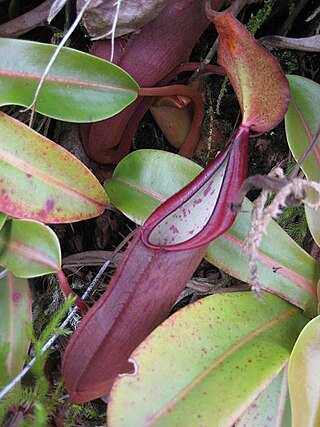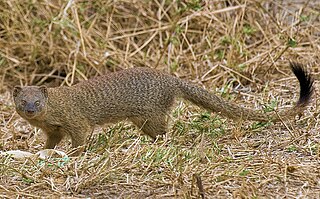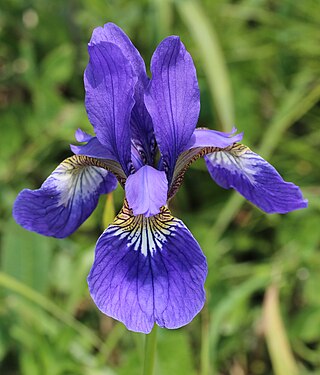
The little corella, also known as the short-billed corella, bare-eyed cockatoo, blood-stained cockatoo, and little cockatoo is a white cockatoo native to Australia and southern New Guinea. It was known as Birdirra among the Yindjibarndi people of the central and western Pilbara. They would keep them as pets, or traditionally cook and eat them. The downy feathers are used in traditional ceremonies and dances where they adorn head and armbands.

Cornus sanguinea, the common dogwood or bloody dogwood, is a species of dogwood native to most of Europe and western Asia, from England and central Scotland east to the Caspian Sea. It is widely grown as an ornamental plant.

Nepenthes sanguinea is a large and vigorous Nepenthes pitcher plant species, native to Peninsular Malaysia and southernmost Thailand, where it grows at 300–1800 metres altitude. The pitchers are variable in size, from 10–30 cm tall, and range from green and yellow to orange and red. The insides of the pitchers are usually speckled with its two main colors. It was introduced to Victorian Britain around 1847 by Cornish plant hunter and botanist Thomas Lobb via the Veitch Nurseries.

Nepenthes junghuhnii is a tropical pitcher plant native to Sumatra. This species has been the source of much confusion since its discovery. The taxon originally named N. junghuhnii by John Muirhead Macfarlane has never been formally published. In 1994, taxonomist Jan Schlauer described N. junghuhnii as a "rather dubious species based on insufficient specimens". Nepenthes junghuhniisensu Macfarlane has not been relocated in the wild since the collection of the type specimen. It is characterised by strongly petiolate leaves and appears to be most closely related to N. bongso and N. spathulata; Schlauer considers it a possible synonym of the former.

The common slender mongoose, also known as the black-tipped mongoose or the black-tailed mongoose, is a very common mongoose species native to sub-Saharan Africa.

Formica sanguinea, or blood-red ant, is a species of facultative slave-maker ant in the genus Formica characterized by the ability to secrete formic acid. It ranges from Central and Northern Europe through Russia to Japan, China, the Korean Peninsula, Africa and also the United States. This species is coloured red and black with workers up to 7 mm long.

Amelanchier sanguinea, known as red-twigged shadbush or roundleaf serviceberry, is a shrub native to eastern and central North America. Its native range stretches from New Brunswick to Saskatchewan south as far as northern Georgia. It is most common in eastern Canada, the northeastern United States, and the Great Lakes region.

Sarcodes is the monotypic genus of a north-west American flowering springtime plant in the heath family (Ericaceae), containing the single species Sarcodes sanguinea, commonly called the snow plant or snow flower. It is a parasitic plant that derives sustenance and nutrients from mycorrhizal fungi that attach to tree roots. Lacking chlorophyll, it is unable to photosynthesize. Ectomycorrhizal (EM) symbioses involve a mutualism between a plant root and a fungus; the plant provides fixed carbon to the fungus and in return, the fungus provides mineral nutrients, water, and protection from pathogens to the plant. The snow plant takes advantage of this mutualism by tapping into the network and stealing sugars from the photosynthetic partner by way of the fungus. This is known as mycoheterotrophy. The snow plant is host-specific and can only form relationships with the ectomycorrhizal Basidiomycete Rhizopogon ellenae.

Anastrangalia is a genus of beetle in the family Cerambycidae, containing the following species:

Anastrangalia dubia is a species of beetle of family Cerambycidae.
Anastrangalia montana is a species of beetle from family Cerambycidae, that could be found on Crete and Cyprus, in Greece, and in Asian countries like Syria and Turkey. The species, just like their other members of the family, have brown coloured pronotum (males), and black (females).
Anastrangalia laetifica is a species of beetle from family Cerambycidae found in Canada, United States, and Mexico. The males are all black, while the females have 4 black dots on their red coloured elytra. They feed on Frasera albicaulis.
Anastrangalia dissimilis is a species of beetle from family Cerambycidae.
Anastrangalia reyi reyi is a subspecies of beetle from family Cerambycidae, that can be found in such European countries as Austria, Belarus, Czech Republic, Finland, France, Germany, Italy, Poland, Slovakia, Sweden, Switzerland, Ukraine, and the Baltic states.

Anastrangalia reyi sequensi is a subspecies of beetle from the family Cerambycidae, that can be found in such Asian countries as China, Japan, Kazakhstan, and Mongolia. The species have brown pronotum.
Anastrangalia dissimilis dissimilis is a species of beetle from family Cerambycidae.
Anastrangalia kasaharai is a species of beetle from family Cerambycidae that is endemic to Japan. The species are either black or red coloured.
Anastrangalia scotodes is a species of beetle from family Cerambycidae. They live especially in Africa.

Iris sanguinea is a rhizomatous flowering plant in the genus Iris and in the series Sibiricae. It is cultivated as an ornamental plant in temperate regions. It is one of the species considered a Japanese iris. It is from Asia, found between Russia, Mongolia, China, Japan and Korea. It has grey green leaves, an unbranched flowering stem and flowers in reddish-purple shades, from blue to blue-purple, red-violet, with a rare white variant.

Nepenthes malayensis, or the striped Malayan montane pitcher plant, is a large species of carnivorous tropical pitcher plant native and endemic to eastern mountains of Peninsular Malaysia. The peristomes on both upper and lower pitchers are profusely adorned by reddish bands, or stripes, making the species rather attractive. It grows close to mountain summits around 800–1000 m above sea level in partially shaded areas, though some individuals have been seen striving in open areas. The species was first observed in 2018 and initially thought to be conspecific with N. sanguinea. Nepenthes malayensis formal description was published in late 2020 in Kew Bulletin and it is one of the latest three new Malayan species described in the same year. These discoveries have made Peninsular Malaysia home to 15 species of Nepenthes and there are over 150 species of world's Nepenthes with the majority of these are from the Malay Archipelago.












